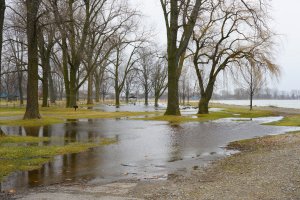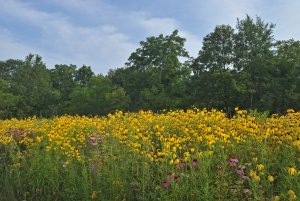Climate Action in #YourMetroparks
November 23, 2022 Erin Parker, Interpretive Services Supervisor
Warm November days in Michigan brought record-setting observations of things like monarch butterflies flying by and black swallowtail caterpillars lingering in still-green gardens. While a single warmer-than-average season doesn’t indicate anything other than the particular weather conditions of a region, years of different-than-average data show trends that suggest shifts in the climate.
One way to think about climate change in the Great Lakes is “warmer, wetter, wilder” because we can measure longer stretches of hotter days, earlier spring warm ups and later autumn cool downs; more frequent precipitation events with more precipitation happening in a given period of time; and large fluctuations in storms, wind, and other “wild” weather events.
Naturalists, park visitors, and outdoor recreation enthusiasts that make late and early season observations of things like butterflies, birds, flowers, and more join a long tradition of the study of phenology- or the timing of natural events as influenced by weather and climate. Some natural phenomena, such as the triggers for birds to begin their migrations, are based on shifting daylight levels as the seasons change. But others, such as bud burst, leaf-out, insect hatching, and more are more closely tied to warming or cooling temperatures
Phenology records were made famous by scientists and writers like Aldo Leopold, whose hand-written records of springtime events in the 1930 and 1940s show a significant change in the onset of spring with warming temperatures, bloom times, and even leaf-out starting about 10 days earlier now that in the 40s. While this often sounds nice to winter-weary Midwesterners, there are real impacts on wildlife, agriculture, and humans.
Birds migrating northward to take advantage of the huge flush of food from insects hatching out in early spring may arrive after these insects peak, losing a critical source of energy right as they need it most. Other insects and arthropods, including ticks and mosquitoes, may have longer seasons that can increase insect-born diseases in humans, pets, domesticated animals, and wildlife.

Heavier and more intense rain events can cause nesting birds to lose their eggs and chicks, prevent farmers from planting in time due to saturated fields, and cause neighborhoods and roads to flood. The impacts of a warmer, wetter, wilder climate are noticeable, too, in fewer days with snow cover and less ice cover on our waterways in the winter. Early spring warm ups may cause earlier spring conditions. Then, a late spring snow, ice, or freeze event can damage leafed-out branches as the snow or ice accumulates, freeze blossoms that then can’t set fruit, and more.
Taking Action
What might climate change actions look like within the Metroparks? There are a variety of actions that can support the longterm health of our parks, wildlife, and visitors.
For example, when we consider replacing trees lost to storms, flooding, and/or drought, we can consider native species that are more forgiving of fluctuating conditions. At Lake St. Clair Metropark, many cottonwoods died after two years of extremely high water levels throughout the Great Lakes that inundated low-lying areas of the park and kept their roots submerged. As some of those trees are removed for safety considerations of park visitors, they will be replaced with species such as swamp white oak, hackberry, and red maple that are more tolerant of changing water levels and that can survive both droughts and sustained flood events.
Another change is to increase our “no mow” zones and allow native prairie grasses and flowers to flourish in areas that were once managed lawn. This is a simple change that reduces water and mower use, and the deeper-rooted plants help retain moisture in the soil while tolerating drought conditions that may occur during longer, hotter summers. There are wildlife benefits, too, in the increase in native flora for food and shelter.

At home and in our parks, we can also consider things like recycling and composting, replacing gas-powered tools and equipment with electric, and considering climate-resiliency as part of the planning process for projects, plantings, and structures. Climate resiliency means that projects take into consideration – those warmer, wetter, wilder weather events and seasons that are more likely to happen with a changing climate. Examples of this might include plantings of plants that can withstand both flood and drought or species that don’t require long, cold winters to survive if our southeastern Michigan winters are going to be shorter and warmer. Other examples might be considering how to build structures such as boardwalks that will withstand longer periods of seasonal flooding.
Look for more about the Metroparks Climate Action Plan, informed by staff, experts, and visitors like you, in the coming months.
To read more about how phenological data is used to understand climate change: https://www.aldoleopold.org/wp-content/uploads/2020/09/2013-paper.pdf
To read more about climate change impacts people in Michigan:
To read more about climate change impacts on agriculture, ecosystems, and more:
https://19january2017snapshot.epa.gov/sites/production/files/2016-09/documents/climate-change-mi.pdf
